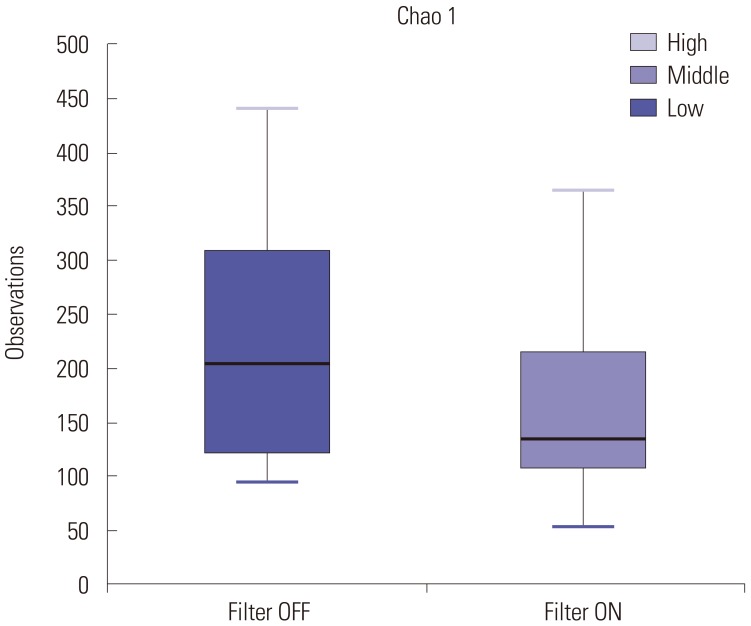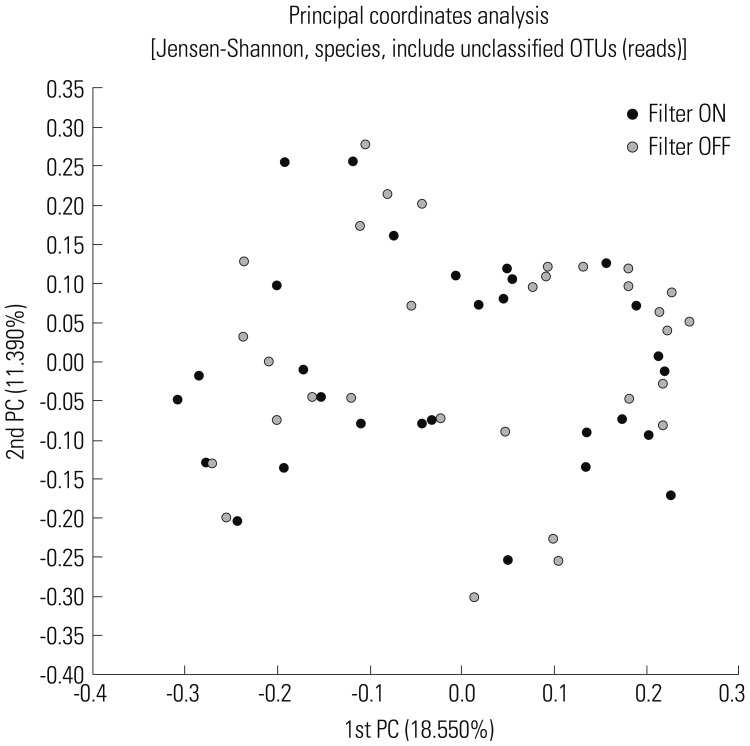Yonsei Med J.
2020 Apr;61(4):310-316. 10.3349/ymj.2020.61.4.310.
Effects of Indoor Air Purifiers on Children with Asthma
- Affiliations
-
- 1Departmenet of Pediatrics, School of Medicine, Inha University, Incheon, Korea. dhyunlim@inha.ac.kr
- 2Environmental Health Center for Allergic Disease, Inha University Hospital, Ministry of Environment, Incheon, Korea.
- 3Department of Environmental Health Sciences, Soonchunhyang University, Asan, Korea. sungroul.kim@gmail.com
- 4Integrated Research Center for Risk Assessment, Soonchunhyang University, Asan, Korea.
- KMID: 2471916
- DOI: http://doi.org/10.3349/ymj.2020.61.4.310
Abstract
- PURPOSE
To evaluate the effects of air purifiers on the concentrations of indoor air pollutants and on asthma control in children.
MATERIALS AND METHODS
In this randomized crossover trial, daily use of an air purifier filter was compared with a matched placebo with the filter off. Thirty elementary school students who had asthma were enrolled and randomly allocated to one of two groups. The primary endpoints were changes in indoor air quality, asthma severity, lung function, airway inflammatory, urine microbiome, and phthalate after the installation of air purifiers. PM(2.5) and COâ‚‚ were measured as indoor air pollutants. Asthma severity was assessed in terms of both symptom and medication scores acquired using a daily questionnaire. The higher the score, the better the symptom or the less frequent the use of medication. Peak expiratory flow rate and fractional exhaled nitric oxide were also measured.
RESULTS
The mean age of the enrolled patients was 9.2±1.98 years. The mean concentration of PM2.5 was 17.0 µg/m³ in the filter-off condition, but significantly lower at 9.26 µg/m³ in the filter-on condition. Medication scores were 6.9 for the filter-off and 7.12 for the filter-on conditions, reflecting a statistically significant decrease in the frequency of medications used during air purifier operation. Bacterial richness, as determined using the Chao 1 index, was markedly lower in the filter-on than the filter-off condition.
CONCLUSION
This study suggests that air purifiers benefit medication burden in children with asthma by reducing PM(2.5) levels.
Keyword
MeSH Terms
Figure
Reference
-
1. Park C. Air purifier market and technology trends. J Korea Inst Archit Sustain Environ Build Syst. 2016; 10:7–11.2. Guarnieri M, Balmes JR. Outdoor air pollution and asthma. Lancet. 2014; 383:1581–1592. PMID: 24792855.
Article3. Breysse PN, Diette GB, Matsui EC, Butz AM, Hansel NN, McCormack MC. Indoor air pollution and asthma in children. Proc Am Thorac Soc. 2010; 7:102–106. PMID: 20427579.
Article4. Park HC, Kim YH, Kim JE, Ko JY, Nam Goung SJ, Lee CM, et al. Effect of air purifier on indoor air quality and atopic dermatitis. Allergy Asthma Respir Dis. 2013; 1:248–256.
Article5. Park HK, Cheng KC, Tetteh AO, Hildemann LM, Nadeau KC. Effectiveness of air purifier on health outcomes and indoor particles in homes of children with allergic diseases in Fresno, California: a pilot study. J Asthma. 2017; 54:341–346. PMID: 27723364.
Article6. Webley WC, Aldridge KL. Infectious asthma triggers: time to revise the hygiene hypothesis? Trends Microbiol. 2015; 23:389–391. PMID: 26070971.
Article7. Jaakkola JJ, Knight TL. The role of exposure to phthalates from polyvinyl chloride products in the development of asthma and allergies: a systematic review and meta-analysis. Environ Health Perspect. 2008; 116:845–853. PMID: 18629304.
Article8. Global Initiative for Asthma. Global strategy for asthma management and prevention. 2018. accessed on 2018 August 1. Available at: https://ginasthma.org/wp-content/uploads/2019/01/2018-GINA.pdf.9. Environmental Protection Agency. Automated equivalent method (EQPM-1090-079). Fed Regist. 1990; 55:43406.10. Murphy KR, Zeiger RS, Kosinski M, Chipps B, Mellon M, Schatz M, et al. Test for Respiratory and Asthma Control in Kids (TRACK): a caregiver-completed questionnaire for preschool-aged children. J Allergy Clin Immunol. 2009; 123:833–839. PMID: 19348922.
Article11. American Thoracic Society. European Respiratory Society. ATS/ERS recommendations for standardized procedures for the online and offline measurement of exhaled lower respiratory nitric oxide and nasal nitric oxide, 2005. Am J Respir Crit Care Med. 2005; 171:912–930. PMID: 15817806.12. Lee EY, Bang JY, Park GW, Choi DS, Kang JS, Kim HJ, et al. Global proteomic profiling of native outer membrane vesicles derived from Escherichia coli. Proteomics. 2007; 7:3143–3153. PMID: 17787032.13. Bolger AM, Lohse M, Usadel B. Trimmomatic: a flexible trimmer for Illumina sequence data. Bioinformatics. 2014; 30:2114–2120. PMID: 24695404.
Article14. Masella AP, Bartram AK, Truszkowski JM, Brown DG, Neufeld JD. PANDAseq: paired-end assembler for illumina sequences. BMC Bioinformatics. 2012; 13:31. PMID: 22333067.
Article15. Eddy SR. Accelerated profile HMM searches. PLoS Comput Biol. 2011; 7:e1002195. PMID: 22039361.
Article16. Lee B, Moon T, Yoon S, Weissman T. DUDE-Seq: fast, flexible, and robust denoising for targeted amplicon sequencing. PLoS One. 2017; 12:e0181463. PMID: 28749987.
Article17. Edgar RC. Search and clustering orders of magnitude faster than BLAST. Bioinformatics. 2010; 26:2460–2461. PMID: 20709691.
Article18. Myers EW, Miller W. Optimal alignments in linear space. Comput Appl Biosci. 1988; 4:11–17. PMID: 3382986.
Article19. Edgar RC, Haas BJ, Clemente JC, Quince C, Knight R. UCHIME improves sensitivity and speed of chimera detection. Bioinformatics. 2011; 27:2194–2200. PMID: 21700674.
Article20. Fu L, Niu B, Zhu Z, Wu S, Li W. CD-HIT: accelerated for clustering the next-generation sequencing data. Bioinformatics. 2012; 28:3150–3152. PMID: 23060610.
Article21. Samet JM, Dominici F, Curriero FC, Coursac I, Zeger SL. Fine particulate air pollution and mortality in 20 U.S. cities, 1987-1994. N Engl J Med. 2000; 343:1742–1749. PMID: 11114312.
Article22. Song DJ, Choi SH, Song WJ, Park KH, Jee YK, Cho SH, et al. The effects of short-term and very short-term particulate matter exposure on asthma-related hospital visits: National Health Insurance data. Yonsei Med J. 2019; 60:952–959. PMID: 31538430.
Article23. Wood RA. Air filtration devices in the control of indoor allergens. Curr Allergy Asthma Rep. 2002; 2:397–400. PMID: 12165206.
Article24. Wang L, Cheng H, Wang D, Zhao B, Zhang J, Cheng L, et al. Airway microbiome is associated with respiratory functions and responses to ambient particulate matter exposure. Ecotoxicol Environ Saf. 2019; 167:269–277. PMID: 30342360.
Article25. Hong SN, Park P, Cho SH, Kim DY. Microbiome of the upper airway focusing on chronic rhinosinusitis and allergic rhinitis. Allergy Asthma Respir Dis. 2016; 4:399–405.
Article26. Hashimoto K, Kawakami Y. Effectiveness of airborne fungi removal by using a HEPA air purifier fan in houses. Biocontrol Sci. 2018; 23:215–221. PMID: 30584208.
Article27. Fromme H, Lahrz T, Kraft M, Fembacher L, Dietrich S, Sievering S, et al. Phthalates in German daycare centers: occurrence in air and dust and the excretion of their metabolites by children (LUPE 3). Environ Int. 2013; 61:64–72. PMID: 24103347.
Article28. Jepsen KF, Abildtrup A, Larsen ST. Monophthalates promote IL-6 and IL-8 production in the human epithelial cell line A549. Toxicol In Vitro. 2004; 18:265–269. PMID: 15046772.
Article29. Wormuth M, Scheringer M, Vollenweider M, Hungerbühler K. What are the sources of exposure to eight frequently used phthalic acid esters in Europeans? Risk Anal. 2006; 26:803–824. PMID: 16834635.
Article30. Correia-Deur JE, Claudio L, Imazawa AT, Eluf-Neto J. Variations in peak expiratory flow measurements associated to air pollution and allergic sensitization in children in Sao Paulo, Brazil. Am J Ind Med. 2012; 55:1087–1098. PMID: 22544523.
Article
- Full Text Links
- Actions
-
Cited
- CITED
-
- Close
- Share
- Similar articles
-
- Effects of Air Purifiers on Patients with Allergic Rhinitis: a Multicenter, Randomized, Double-Blind, and Placebo-Controlled Study
- The impact of indoor air pollution on asthma
- Prevention of exposure to and spread of COVID-19 using air purifiers: challenges and concerns
- Distribution of Fungus Spores in Indoor and Outdoor Air
- Effect of air purifier on indoor air quality and atopic dermatitis




